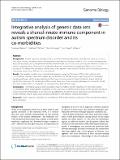Integrative analysis of genetic data sets reveals a shared innate immune component in autism spectrum disorder and its co-morbidities
Author(s)
Palmer, Nathan P.; Kohane, Isaac S.; Nazeen, Sumaiya; Berger, Bonnie A.
Download13059_2016_Article_1084.pdf (2.142Mb)
PUBLISHER_CC
Publisher with Creative Commons License
Creative Commons Attribution
Terms of use
Metadata
Show full item recordAbstract
Background: Autism spectrum disorder (ASD) is a common neurodevelopmental disorder that tends to co-occur with other diseases, including asthma, inflammatory bowel disease, infections, cerebral palsy, dilated cardiomyopathy, muscular dystrophy, and schizophrenia. However, the molecular basis of this co-occurrence, and whether it is due to a shared component that influences both pathophysiology and environmental triggering of illness, has not been elucidated. To address this, we deploy a three-tiered transcriptomic meta-analysis that functions at the gene, pathway, and disease levels across ASD and its co-morbidities.
Results: Our analysis reveals a novel shared innate immune component between ASD and all but three of its co-morbidities that were examined. In particular, we find that the Toll-like receptor signaling and the chemokine signaling pathways, which are key pathways in the innate immune response, have the highest shared statistical significance. Moreover, the disease genes that overlap these two innate immunity pathways can be used to classify the cases of ASD and its co-morbidities vs. controls with at least 70 % accuracy.
Conclusions: This finding suggests that a neuropsychiatric condition and the majority of its non-brain-related co-morbidities share a dysregulated signal that serves as not only a common genetic basis for the diseases but also as a link to environmental triggers. It also raises the possibility that treatment and/or prophylaxis used for disorders of innate immunity may be successfully used for ASD patients with immune-related phenotypes.
Date issued
2016-11Department
Massachusetts Institute of Technology. Computer Science and Artificial Intelligence Laboratory; Massachusetts Institute of Technology. Department of Electrical Engineering and Computer ScienceJournal
Genome Biology
Publisher
BioMed Central
Citation
Nazeen, Sumaiya et al. “Integrative Analysis of Genetic Data Sets Reveals a Shared Innate Immune Component in Autism Spectrum Disorder and Its Co-Morbidities.” Genome Biology 17.1 (2016): n. pag.
Version: Final published version
ISSN
1474-760X